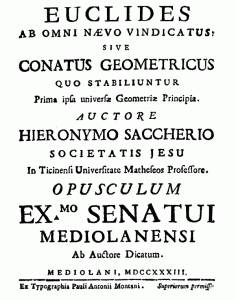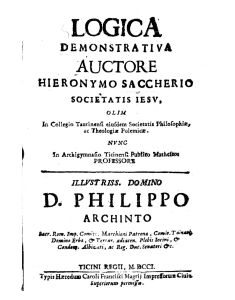Mathematician and philosopher
 On 5th September 1667 Giovanni Girolamo Saccheri, a Jesuit, mathematician and philosopher, was born in Sanremo. He was unanimously considered the father of non-Euclidean geometries.
On 5th September 1667 Giovanni Girolamo Saccheri, a Jesuit, mathematician and philosopher, was born in Sanremo. He was unanimously considered the father of non-Euclidean geometries.
Saccheri was the son of a lawyer from Sanremo who was part of a family of citizens who exercised the notarial profession. Mr. Bianco, who knew him, says that he was suffering from a slight limp due to a fall from a tree, where as a child he stayed for a few days not wanting to go ashore. His example would have been followed with more luck and perseverance by the little Cosimo dei Baroni from nearby Ombrosa.
An early talent, at the age of eighteen Girolamo entered the Jesuit order in Genoa. There he studied philosophy and theology until his superiors sent him to Milan to the Brera College, where he was noticed by Mr. Tommaso Ceva, who directed him to the study of the Elements of Euclid. This Tommaso had a brother named Giovanni who had become a mathematician of the Duke of Mantua and was a great surveyor. The two brothers had a great influence on the young Saccheri, who fell in love with mathematics.
The young Saccheri soon became so skilful with tuition and angles that he published a book of "Quaesita geometrica" at the age of twenty-six, the year before receiving orders and being transferred to Turin.
Astute, prudent, of fine and seductive eloquence, in the subalpine capital he became familiar with Duke Vittorio Amedeo, who took him under his protection, entrusting him with diplomatic duties and calling him whenever he was presented with a difficult mathematical problem to solve. He was given a larger room in the college of Jesus' servants, furnished  with taste and simplicity, where he studied and received visitors when he was not busy teaching mathematics and logic.
with taste and simplicity, where he studied and received visitors when he was not busy teaching mathematics and logic.
The result of three years of teaching was the small treatise on "Logica demonstrativa".
The story of this booklet is curious. The first edition of the logic course appeared with the name of Count Gravere, who was a student of Saccheri, who had preferred to keep himself in the shadow of his pupil's title. Perhaps he was not sure of what he had written and feared that any criticism could harm his career. The fact remains that, immediately after publication, the Jesuit was transferred to Pavia. The second edition came out four years later, with minor changes, this time with the name of the real author and the dedication to Count Filippo Archinto of the Senate of Milan. Later Saccheri referred only to this second edition.
Saccheri's logic is based on the study of definitions.
In Pavia he taught at the Jesuit College and held the chair of mathematics at the University for the rest of his life. Three decades after the publication of the book of demonstrative logic, the Duke of Savoy Vittorio Amedeo tried to bring him back to Turin, offering him the chair of mathematics, but the servant of Jesus chose to stay in Ticino. It is also said that the Duke came to offer him the office of bishop, but this detail seems to be an unfounded voice. It is true, however, that Saccheri refused the chair of mathematics in Padua.
One day, when he had reached the sixty-fifth year of his earthly life, it seemed to him that the parallel vertical lines painted on a water pitcher moved away on his belly, where the convexity was more accentuated, and came closer above, where the connection to the opening was concave at its maximum. It was the impression of a moment, because Euclid postulated that parallel lines are always equidistant. The criticism that the Englishman John Wallis and the Arabic al-Tusi had made of the postulate of the parallels seemed to him ungenerous and arrogant. He decided to prove it and defend Euclid, not content with a simple quid nominis.
He then wrote a volume entitled "Euclides ab Omni Naevo Vindicatus" (Euclid avenged by every mole), which contained his demonstration: using a particular procedure of demonstration for absurd (elaborated in Logica demonstrativa, 1697), he tried to demonstrate the 5th postulate of Euclid's Elements: "for a point outside a straight line only one parallel to the given straight line passes" (Euclides ab omni naevo vindicatus, 1733). He therefore assumed the negation of the 5th postulate and tried to derive a contradiction from it. The demonstration is wrong in the sense that it implicitly admits other propositions, equivalent to Euclid's 5th postulate, which is not a consequence of the previous ones. Saccheri's work has, however, great importance in the history of mathematics because he was the first to conceive the idea of seeing what consequences it would come to by denying the 5th postulate, and therefore gave, without seeking them, the first theorems of non-Euclidean geometry.
Girolamo Saccheri died in Milan on 25 October 1733, a few months after his book had obtained the imprimatur of the Society of Jesus. It has been said that his work, with the possibility of hypothesizing the non-validity of the fifth postulate, opened the doors to a new type of geometry "non-Euclidean geometries" without however he could have noticed it because of his unshakeable faith in traditional geometry.
On the occasion of the bicentenary of his death, the Municipal Administration placed a plaque in his memory on the portico of the University of Pavia, where he had taught from 1699 until his death.
In 1949 the Administration dedicated to him the stretch of road that links via Corradi with Corso degli Inglesi, on one side of via Massabò and on the other side of via Costiglioli. Until that date the stretch from the Piano to Piazza San Bernardo was called via Costiglioli.
In 1973, in Sanremo, the Liceo Scientifico was established and named in his honour. Later, in 2000, unfortunately, Gian Domenico Cassini was incorporated into the Liceo Classico.
(Text by Marco Mauro)




